United States Unfolding Financial and Economic Nightmare
Stock-Markets / Recession 2008 - 2010 Jul 22, 2008 - 05:46 AM GMT Martin D. Weiss writes: The rally you saw last week was little more than a normal, bear-market bounce — predicated on the myth of government omnipotence ... spurred by the blind faith in fiat money ... and triggered by the official attacks on short-sellers.
Martin D. Weiss writes: The rally you saw last week was little more than a normal, bear-market bounce — predicated on the myth of government omnipotence ... spurred by the blind faith in fiat money ... and triggered by the official attacks on short-sellers.
For investors who jump into financial and other vulnerable stocks now, it's a trap door. But for those who feel like they're still stuck in all the stocks we've been telling you to get rid of, it's an escape hatch. Use it as your selling opportunity. And don't look back.
We spelled out the reasons in our Special Midyear Update. And behind me on my monitor is just one of them.
I hope you were able to attend. But whether you did or not, this gala, double-length edition of Money and Markets is the edited transcript, which I've taken the liberty to update with the latest inflation numbers ...
Special Midyear Update
The Great American Nightmare:
What Washington Won't Tell You About
This Unfolding Financial Debacle
(Edited Transcript)
Martin Weiss: This is the first stage of the dangerous bear market we've been warning you about. And just as we've warned, the market is being driven down by the single most important sector: Financial companies, the heartbeat of our economy.
Nearly every major bank, brokerage and lender you can name is up to its eyeballs in leveraged investments whose value is going up in smoke. They're borrowing hundreds of billions from the Fed. They're raising billions more from investors, diluting their shares. They're selling massive amounts of assets — scrambling any way they can to raise cash to survive.
Merrill Lynch, America's largest brokerage firm, has lost more than two thirds of its stock value. Citigroup, once America's largest bank by market cap, has lost even more. Washington Mutual has given up nine tenths of its value. On average, even including the strongest of the banks, half of the wealth of bank shareholders has been wiped out.
This is the first stage of the deep recession we've been warning you about. Banks have no choice but to deny loans to all but the most highly qualified borrowers; and as a result, corporations and consumers have no choice but to cut back on their spending.
Consumer confidence is the worst since 1980. Mortgage default rates are the worst since the 1970s. Even the government's highly suspect official numbers show that the growth of the U.S. economy is grinding to a halt.
This is also bringing the runaway inflation we've been warning you about, with oil and energy leading the way. This time, unlike the 1970s when we had artificial energy shortages created by OPEC or by Iran, the planet is confronting chronic, long-term energy shortages.
But at each step of the way, what truly angers me is that our government leaders — the very people we elect to protect our interests — continually minimize, downplay and sugarcoat this crisis.
First, they told us it would be limited to the subprime mortgage market. Then, they told us it would be limited to housing. And of course, every time the Fed pumped in more money for a new bail-out, they swore on a stack of Bibles that it would not re-ignite inflation.
The gap between what you see and what they say has never been greater. Today, we're going to show you how they're cooking the nation's books, distorting key economic data, and perpetuating the deception that things aren't nearly as bad as they really are. And we're going to show you why this great deception is, in itself , one of the greatest dangers of all.
As grim as the situation is, though, never forget: As a nation, we will get through this. We faced reality in the Great Depression and we created a stronger country as a result. We faced reality during World War II and we helped create a better world in its aftermath. And that's what we need to do again — face reality.
But right now, unfortunately, we live in two worlds. We live in a real world that average citizens experience each day — sinking home values, surging gas and food prices, the disappearance of easy credit. Plus, we live in a fantasy world that Washington bureaucrats have created — an American economy that they say is "still growing," inflation that they say is still "still moderate," a credit crisis that they repeatedly say has been "overcome."
How big is the gap between fiction and reality? Is it getting bigger? What are the real consequences for investors?
To help us answer those questions, John Williams, the founder of Shadow Government Statistics , was scheduled to join us. But John had a personal conflict and couldn't make it today. So he will join us on another occasion.
Separately, our own Larry Edelson has been issuing similar warnings about the government's rigged numbers for many years. And he knows John Williams' work very well. So we've invited Larry to provide his own analysis, based on Mr. Williams' data and writing. Thank you for joining, Larry.

Larry Edelson: Thank you! Since the 1980s, Washington has changed and manipulated the way it measures almost every major economic stat — inflation, GDP, unemployment, even money supply — to fit its own political agenda.
John Williams ( www.shadowstats.com ) is a real number cruncher, and he has exposed this deception by continuing to measure those key numbers the same way the government used to, using the same metrics the government used to swear by!
Martin: Can you give us some specific examples?
Larry: Sure. First, GDP growth. The government's figures show we had a mild and brief recession in 2002, and then a recovery in the years since. That's the gray area on this chart.
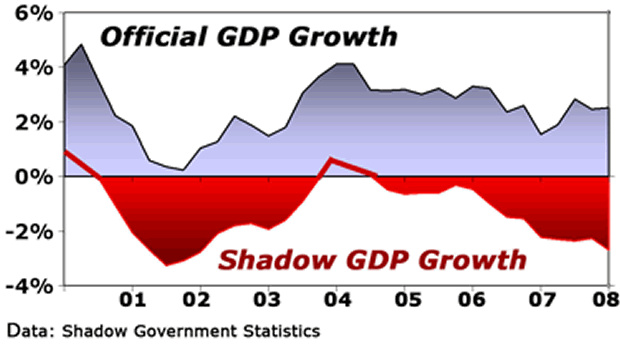
Now, here's the reality in red, based on Shadow Government Statistics: We had a much deeper recession in 2002, an attempt to recover, and more recently, a second recession starting in late 2006 or early 2007. In other words, the big picture for this entire decade is a double-dip recession. Meanwhile, the government claims we're not in a recession. It's ridiculous.
The unemployment situation is also much worse than the government admits: The government publishes a whole series of unemployment numbers — U1, U2, all the way up to U6. But the most widely used unemployment rate — the one the public hears about every month — is U3. Here's the line representing U3. It's now at 5.5%.
Plus, the government also publishes the unemployment rate called U6, which is the government's broadest measure. That's now at 9.7%.
Martin: Most people aren't aware that the government itself admits we have 9.7% unemployment in the U.S. But on top of that, you're saying it's even worse?
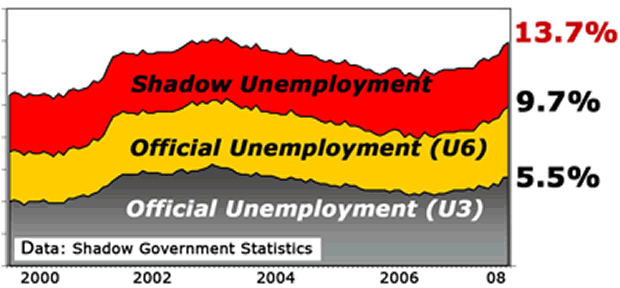
Larry: Yes, during the Clinton Administration, the government decided to stop counting long-term discouraged workers — people who had given up looking for a job for more than a year.
Result: The number of discouraged workers in their stats dropped from the 5 million range to less than 500,000.
Martin: So 4.5 million discouraged workers magically disappeared from the government's unemployment count?
Larry: Into thin air! Like they didn't exist! So you have to add those discouraged workers back into the ranks of the unemployed, just like they did before the Clinton years.
Martin: So what's the broadest measure of unemployment today, based on the way the government used to calculate it?
Larry: It's this red area — 13.7% unemployment. That's much closer to the true unemployment rate in the U.S.
Martin: That's hard for most people to believe.
Larry: Is it really? I think it's very consistent with the fact that so many Americans are suffering an income crunch. And it also jibes with the fact that so many Americans have had to borrow so heavily to make ends meet.
Martin: That makes sense. If people are wondering, "Why was the Fed so frightened in the early part of this decade? Why did they pump up the housing bubble? Why did Americans take out so many home equity loans?" — then this picture you're painting of the true GDP and the true unemployment helps us answer those questions.
Larry: Yes, it does. And now, here we are, with America's banks facing the consequences. And here we are, with a Fed that's going nuts trying to rescue those banks. In fact, the Fed's own data is good evidence of this.
Martin: Please show us that evidence.
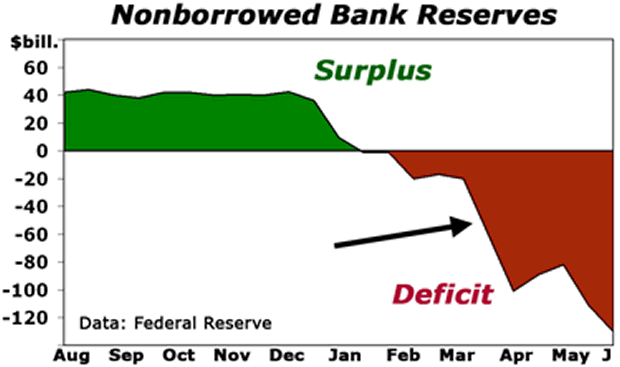
Larry: It's called nonborrowed bank reserves. This is a measure of precisely how much the Fed has been bailing out the banks with its special lending operations. About a year ago, the banks had about $40 billion in net nonborrowed reserves. That's total bank reserves less borrowed reserves.
But look at this: Now their net borrowed reserves are $130 billion below zero. That's a $170 billion swing into the negative — and it reflects the amount the Fed has been lending them with all of its new special lending facilities that everyone's been hearing about.
Martin: With this kind of money pumping, the money supply must be growing by leaps and bounds.
Larry: Martin, remember when the Federal Reserve stopped publishing one of the broadest measures of money supply, and I wrote that they must be doing it to hide something?
Martin: You were talking about the M3 money supply.
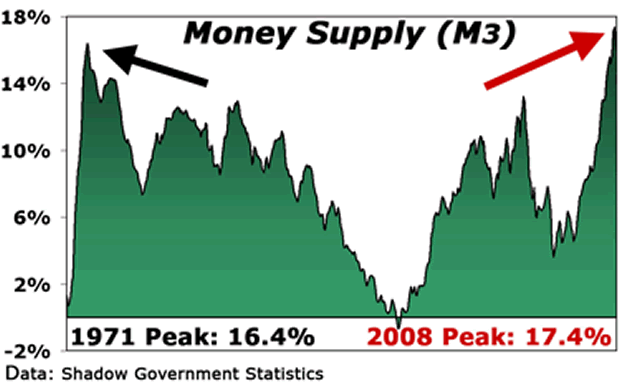
Larry: Yes, M3. Fortunately, John Williams continues to estimate M3; and sure enough, in May, the annual M3 growth was galloping along at the pace of 16% . In March, it was even higher — over 17%. Heck, the last time we saw these kinds of numbers was in the 1970s — before inflation soared far into double digits!
The key is how the official Consumer Price Index — the CPI — is also being used to brainwash the public, unfortunately.
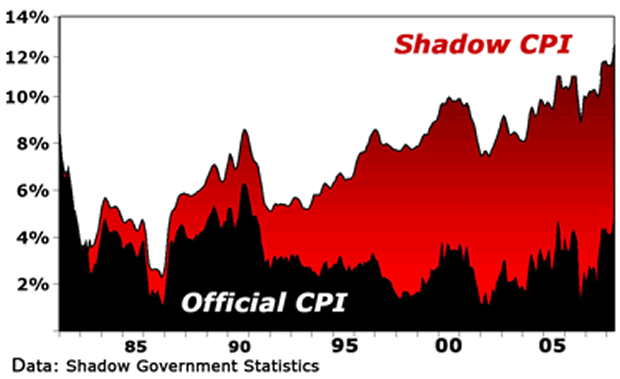
Here's the CPI: 5% inflation. I guess if you don't eat, don't drive or don't buy anything, or if you're in high office and all that is taken care of for you, then maybe you're experiencing low inflation. But for nearly all other Americans, the government's CPI figures are horribly understated.
Martin: Explain how that's done.
Larry: Starting in the 1980s, the government made two major, fundamental changes to the way they calculate the CPI.
First, they began making adjustments for the quality of the products. For example, if a textbook has color pictures in it, they say it has a higher value and, therefore, they recognize only a portion of the price increase.
Martin: But as a practical matter, if a college professor requires a certain textbook, the student still has to buy it and pay whatever it costs, right?
Larry: Of course! The second major thing they did was to plot some key items on a log scale. The net result is that they reduce the weight of items that go up in price, but increase the weight of items that go down in price. It's absurd, but they did it for a reason: To hold down the inflation adjustment for Social Security payments. Their real agenda was to underpay retirees by covering up the true inflation.
Martin: Let's assume the government never changed the CPI. And let's calculate the CPI the way they did before these changes were made.
Larry: Then you'd get the red area in this chart: According to Shadow Government Statistics, consumer price inflation in America is now galloping along at the rate of 12.6% per year.
Martin: 12.6% consumer price inflation in the United States today!
Larry: Yes. And I think that jibes with most people's experience. That's why foreign investors are getting fed up with our dollar. That's how the world is buried in a tsunami of counterfeit dollars — and every one of them is falling in value, gutting the buying power of your dollars at the rate of 12.6% per year! At that rate with compounding, your cost of living doubles in less than six years!
Martin: Which is maddening for people on fixed incomes.
Larry: Absolutely maddening. You have millions of people who scrimped, saved and invested to build a nest egg — to ensure a dream retirement. Now, many could wind up barely surviving, financially dependent on their families. Plus, you have millions of people who are losing their #1 source of retirement savings — the equity in their homes. Worst of all, you have millions of people who trust the government's numbers and are sleepwalking towards disaster. That's what we're so worried about.
Martin: In your opinion, what's the worst-case scenario?
Larry: The worst-case scenario is a hyperinflationary depression. But whether it goes that far or not, I think we're going to see one of the greatest inflationary spirals in decades. That sums up my views. But now I think our subscribers would like to get your analysis.
Martin: To me, Williams' story is not just about revealing the government's distorted data or about past events. It's also a real and present danger now . History proves that the truth can never be hidden forever. The truth always comes out. People suddenly see — in a flash of lightning — that the emperor has no clothes. That's when you get panic in the financial markets, when people dump their stocks and bonds. And right now, after years of bliss, I think that rude awakening could be very close.
Larry: What makes you say that?
Martin: Because of a few things we're watching very closely.

First, the consumer confidence numbers. Remember: These numbers are not subject to Washington's distortions. And right now, according to the Conference Board, consumer confidence has plunged all the way from 105.3 to 50.4, its lowest level in 16 years. Plus, their index that measures future expectations has nosedived to 41, the lowest level in four decades. That plunge in consumer confidence tells me the public is coming closer to a rude awakening.
Second, we have the polls in the presidential election campaign. Those polls imply a massive distrust and disbelief in Washington about the economy — another confirming signal to me that America is close to a rude awakening.
Third, the folks in Washington can only cook some of their books some of the time. They can't cook all the books all the time. So even the government's numbers are now starting to reveal tough times: You have unemployment surging by a half point, the worst in decades. You have inflation now more than double what it was a year ago. And the official numbers prove that the banking crisis is now much worse than last year, when they were saying "it couldn't possibly get any worse."
Larry: The big question is: How much worse could it get?
Martin: I've been talking to some folks in Washington and on Wall Street. In private, they're telling a very different story from what you hear them saying in public. They're saying one reason bank stocks have gotten clobbered so badly is because the pros now see another meltdown on the horizon, beyond Fannie Mae and Freddie Mac. But next time, because of inflation fears, they're worried the Fed will not come to the rescue in the same way as it has done so far. And it could be ugly.
Larry: I disagree. I think the Fed will do whatever it takes. And that translates into even more money pumping and even more inflation.
Martin: Either way, the unspoken concern on Wall Street is that the next shoe to fall could be a Wall Street firm that's far larger. Perhaps a Merrill Lynch or a Citigroup or a Washington Mutual. If that's the case, you'd have a company that's too big to fail ... but that's also too big to save. So the Fed's response is bound to be more complex than what you've seen so far.
Larry: I don't think there's anything complex about it. The bigger the failure, the more money the Fed's going to pour in. It's hard for me to believe it's going to let a Citibank or a Bank of America or a GM fail. I guess anything's possible. But I think the Fed will do everything in its power to keep the system afloat, no matter how much money is required, no matter how much inflation it generates, no matter how low the dollar goes.
Martin: Larry, it's a moot point. Because in either scenario, the U.S. dollar suffers. It suffers when U.S. banks and lenders fail. And it suffers when the Fed pumps in hundreds of billions in unbacked dollars to rescue those banks and lenders.
Ultimately, the dollar reflects everything we've been talking about today. The dollar falls when the U.S. stock and bond markets fall. The dollar falls when the U.S. sinks into a recession. The dollar is slammed by inflation, which obviously erodes its purchasing power.
Plus, today, we've talked about still another danger for the dollar: What happens when international investors suddenly discover that our inflation, our unemployment — our entire economy — are far worse than the U.S. government has been letting on. They're likely to dump the U.S. dollar in a panic.
So it all boils down to the dollar in the currency market. That's why I've invited one of the world's foremost currency experts, Jack Crooks, to join us today as well. And that's why I think the opportunities Jack offers could be a part of the solution for investors. But before we go to Jack, I want to focus everyone's attention on a few basic steps I think you must take to protect yourself.
Step one: If you haven't done so already based on our earlier warnings, get the heck out of vulnerable stocks and bonds. We knew the situation was bad. What the material from John Williams is telling us is that, behind the façade the government has created, the situation is actually much worse . So get out of bank stocks. Get out of housing stocks. Get out of tech stocks. Get out of industrial stocks. Whether you have a profit or a loss, get out.
Step two: If you have vulnerable stocks you cannot sell, then at least hedge by buying the inverse ETFs we've recommended, such as SRS or REW.
Step three: Build a nice cash hoard — in Treasury bills or equivalent.
Larry: In dollars?
Martin: Partially, yes. If you're a resident in the U.S., if you have most of your accounts here in the U.S., you still need dollars. But that leads me to your fourth step: Get a good portion of your money out of the dollar — into the world's strongest foreign currencies.
If you're a relatively conservative investor, I would recommend a mutual fund like the Prudent Global Income Fund, which buys mostly government securities of major foreign countries. Not only does it get you into the currencies, but it also gets you into relatively safe, income-generating securities in those currencies.
Fifth, if you have some speculative funds you can afford to play with, I think one of the biggest potential pay-offs of all is in the currency market. And that's why I've invited Jack to join us today.
Jack, my most urgent question to you is this: If we're right about a financial panic hitting the United States, and if you want to escape that crisis — even profit from that crisis — with just one single currency, which one would you pick?

Jack Crooks: The Swiss franc! But I want to stress that the crisis may not be limited to the United States. The U.K. is also reeling from a real estate crisis. So are a couple of other countries in Europe. My point is that the scared money could rush into the Swiss franc from other areas as well.
Martin: Please explain why the Swiss franc.
Jack: Remember, last year, I told you about the flight of money into the Japanese yen, driving it higher. To a great extent, that's what happened: Scared money rushed into the yen, and investors who played the move in the yen could have made a lot of money. Now, I see a similar flight to quality coming — this time into the Swiss franc.
Despite some exceptional situations, the Swiss franc has always been a great crisis currency. When a crisis shows up anywhere in the world, investors have traditionally rushed to the relative safety of the Swiss franc because of Switzerland's role as a safe haven in a time of turmoil.
Martin: Is that still true today?
Jack: The Swiss are not perfect. They've made mistakes as well. But in some ways, it's even more true today. The Swiss never joined the Eurozone. The Swiss never joined the European Economic Community. So when there's crisis in the world, investors still flock to the Swiss franc. Plus, the Swiss central bank still has a very large reserve of gold relative to other major countries in the world. But the clincher is the Swiss carry trade.
Martin: Please explain the carry trade.
Jack: Here's how it works: For most of this decade, Swiss interest rates have been far lower than those of any other country in Europe. So investors got the brilliant idea that they could simply borrow Swiss francs at low interest rates and buy higher-yielding, riskier instruments elsewhere.
Martin: Could you go through that one step at a time?
Jack: Sure.
Step 1. Investors borrow Swiss francs at very low interest rates.
Step 2. They convert the Swiss francs into U.S. dollars, British pounds and other currencies.
Step 3. They take that money and buy high-yielding, riskier investments.
That's what's called the Swiss franc carry trade. Now, let me show you what's likely to happen next ...
First, the risky investments start going sour — because real estate is collapsing, or stocks are falling, or banks are failing, or some combination.
Second, these investors get scared. They suddenly want to get rid of their riskier investments. So they sell.
Third, they rush to buy back Swiss franc to repay their loans. And when they rush to buy Swiss francs, naturally, they drive up the value of the Swiss franc.
Martin: Can you give us some historical examples of that?
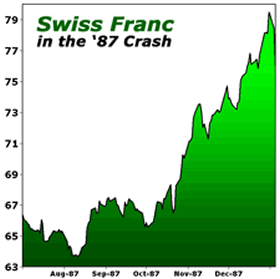
Jack: Take the stock market crash of 1987, for example. While U.S. stocks fell, the Swiss franc enjoyed one of its greatest surges of all time: It jumped from 63 cents before the crash to nearly 80 cents after the crash.
In the currency market, that's a huge move — almost 26% in less than four months. With the leverage available in currencies, just 5% is considered a big move with rich profit potential. So that was over five times larger than what many traders would call a "big" move in the Swiss franc.
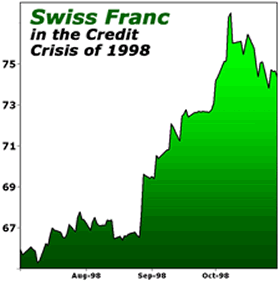
Now, fast forward 11 years and you'll see another major example: The debt crisis of 1998. Russia defaulted on its debt. Long Term Capital Management, the hedge fund loaded with derivatives, went belly-up. U.S. stocks plummeted. And money rushed into crisis currencies like the Swiss franc.
Sure enough, the Swiss franc surged from 66 cents just before the crisis to 79 cents three months later, another huge move — this time close to 20%.
Martin: What about in this credit crunch we're currently experiencing?
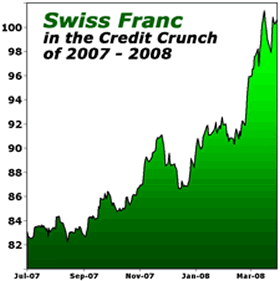
Jack: The Swiss franc surged from a low of 80 in June of 2007 — before the first phase of the credit crunch really hit — to a high of 103.63 in March. That's almost a 30% move, or six times larger than what would normally be considered a big move.
Martin: But from all the evidence, the financial crisis we've seen so far is just the tip of the iceberg. Even the IMF estimates that the financial losses announced so far are less than half the total amount that we'll probably see by the time this crisis is over.
And that's before a recession. So we have to ask: What happens now as the U.S. sinks into a recession? What happens if a company the size of a Merrill Lynch or a Washington Mutual is the next to get into trouble? What does that do to the Swiss franc?
Jack: In that scenario, the flight to crisis currencies like the Swiss franc could make earlier flights seem small by comparison. If the U.S. stock market falls sharply, the flight could be dramatic. If a major U.S. bank or brokerage firm goes down like Bear Stearns did back in March, the flight could also be dramatic.
Martin: Separately, I have also invited Mike Larson to join in this discussion.
When Mike first warned investors about the housing and mortgage crisis a few years ago, laying out exactly how it would unfold and why, he was not exactly a popular figure on Wall Street. And when he presented his white paper to the Federal Reserve and the FDIC — also on the housing and mortgage crisis — it didn't make them very happy either. They vehemently denied even the remotest possibility of his forecasts coming true.
But now, Mike is in great demand. He's continually getting calls to appear on CNBC and Fox or to be interviewed by the Wall Street Journal and the Washington Post. And thanks in good measure to his research, we now have hundreds of thousands of investors getting our reports.
Mike, you've heard what we said about the huge discrepancy between reality and fantasy. But in the housing market, where you're known as a national expert, I get the impression people are finally beginning to face reality. So I sense that, perhaps in the housing sector at least, the discrepancy between fiction and fantasy is not quite as bad.

Mike Larson: Not as bad? In reality, it could actually be worse. Just look at Fannie Mae and Freddie Mac, for example.
Martin: You're talking about the collapse in their shares since the beginning of the year, the collapse in confidence on Wall Street, and the government's massive rescue to avert an even further collapse.
Mike: Yes, and I'm talking about the reasons behind that collapse. Look. These are the giants of the mortgage industry — just two companies responsible for about 50% of all the mortgages in America. Until just recently, most people were counting on them to be the great survivors of the housing bust — and the great saviors of the housing market.
Washington and Wall Street said Fannie and Freddie were immune to the subprime problems. Washington and Wall Street said they had plenty of capital. Congress even passed special legislation increasing the size of the mortgages they could finance — to let them pump still more money into the housing market.
But now, Fannie and Freddie are in deep trouble themselves. Despite the government's rescue, investors are worried about their exposure to complex derivatives. Investors are afraid of the losses they might suffer if the mortgage insurers they rely on go belly-up. And investors are downright petrified that they won't be able to raise the billions of dollars of capital they need.
It all just goes to illustrate what you said earlier: When the truth is bottled up for so long — and then suddenly released in a flash — the consequence is panic.
Martin: Right now, with the latest rescue proposals, you can hear some people again saying that "the crisis is behind us."
Mike: That's exactly what they said last year when central banks pumped in money. And that's exactly what they said in March when the Fed rescued Bear Stearns. They were wrong then — and it's pretty obvious that they're wrong again.
Mike: But what about the housing market itself. Do you agree with folks who say that we're facing reality there?

Mike: In some markets, and with some property types, yes. Banks are slashing the price of foreclosed homes with reckless abandon. Sellers are giving up and just taking whatever price they can get. So there's a bit of recognition — capitulation — and some buying activity. But most of that "bottom-fishing" is predicated on the idea that mortgage giants like Fannie and Freddie would still play a major role in the housing market bailout. Now the whole idea of a rescue by Fannie and Freddie is down the tubes.
Bottom line: Home prices are plunging. But they still have a long way to go.
Martin: So what could ultimately put the housing bust behind us?
Mike: The only thing that could fix it is a wash-out.
Martin: Please describe what that would entail.

Mike: First, mass foreclosures in 2009. Connect the dots: The Treasury Secretary predicted 2.5 million foreclosures for this year. On the same day, the Fed Secretary said the problems will persist deep into next year. So if you put those two statements together and throw in a deep recession, you've got the likelihood of massive foreclosures again next year.
Second, much lower real estate prices! You can't have that many properties being dumped onto auction block and expect prices to "stabilize" as many people are still hoping.
Third, big cutbacks in building activity! Hard to believe, but builders still don't get it. They've cut back, but not nearly enough.
Fourth, lots and lots of time . All this could take years to digest, and most people are still greatly underestimating the magnitude of the problem.
Martin: What are they going to do about Fannie Mae and Freddie Mac?
Mike: Ultimately, they may have to nationalize those companies — take them over entirely. That means the shareholders get wiped out. But it also means taxpayers get shafted. And if you think the Fed money pumping so far is a lot, wait till you see the money pumping that will be needed when Fannie or Freddie collapse and the mortgage market crumbles!
Martin: What new evidence do we have that the mortgage market is crumbling?
Mike: I'll give you a major example: IndyMac — one of the biggest mortgage lenders in the nation — has just failed, as everyone knows. Plus, even before it failed, it shut down nearly all of its mortgage operations.
Martin: Was IndyMac really that big of a player?
Mike: That big? Are you kidding me? Remember when the subprime lender New Century Financial went under in early 2007?

Martin: Yes, of course. We wrote about that in our Safe Money Report well before it happened.
Mike: My point is that in its last full year of operations, New Century made about $60 billion in mortgage loans. Then later last year, another big lender, American Home Mortgage, failed. In its last full year, it wrote about $59 billion in mortgages.
Martin: And IndyMac?
Mike: IndyMac is the biggest of the three. It originated $77 billion worth of mortgages last year. Now, the FDIC has taken over. But they've got their hands full handling depositors. They're not going to lift a finger to revive the mortgage business.
Martin: That's just one company.
Mike: No. IndyMac is far from alone. Almost every day, another regional bank, another mortgage insurer or another broker takes a bath.
For example, Marshall & Ilsley is a midsized bank based in Wisconsin. It said it will have to set aside $900 million in the second quarter to cover losses on housing and construction loans. That was 35 times its loan loss provision of a year earlier. Result: The stock has plunged more than half this year alone!
Then there's Triad Guaranty. It is — or should I say, was — a major mortgage insurer, a company that pays lenders off when borrowers can't make good on their loans. Well, Triad has been losing money hand over fist — including $150 million in the first quarter alone — because losses are off the charts. And now, the company has been forced to stop writing new policies. Its shares traded hands for $58 last January. They go for about 72 cents now.
Or how about Merrill Lynch? Merrill lost $2.2 billion in the third quarter of last year ... $9.8 billion in the fourth quarter ... $1.9 billion in the first quarter of this year ... and another $4.65 billion in the second quarter, far more than expected.
They've already been begging to borrow billions of dollars from sovereign wealth funds and other investors. But even that wasn't enough. The company is now reportedly looking to dump more assets in a fire sale. They're desperately looking for capital, and as I said — as both Bernanke and Paulson admitted — this thing is far from over.
Martin: All the more reason that everyone needs to stay alert, take defensive steps, and be ready for the worst! But it's not all black. Once the worst is over, the economy will recover. And in the days ahead, we will continue to help you find the silver linings. Thank you, Mike, Jack and Larry. Thanks, everyone. And stay tuned!
Martin
This investment news is brought to you by Money and Markets . Money and Markets is a free daily investment newsletter from Martin D. Weiss and Weiss Research analysts offering the latest investing news and financial insights for the stock market, including tips and advice on investing in gold, energy and oil. Dr. Weiss is a leader in the fields of investing, interest rates, financial safety and economic forecasting. To view archives or subscribe, visit http://www.moneyandmarkets.com .
Money and Markets Archive |
© 2005-2022 http://www.MarketOracle.co.uk - The Market Oracle is a FREE Daily Financial Markets Analysis & Forecasting online publication.



